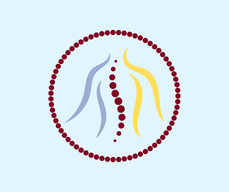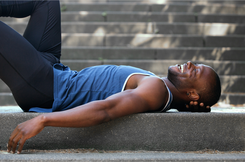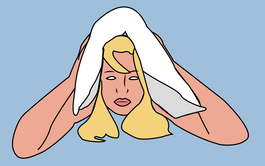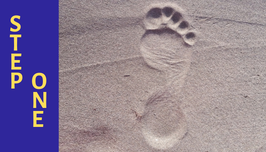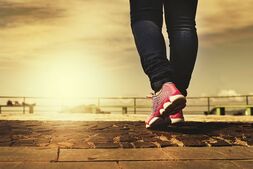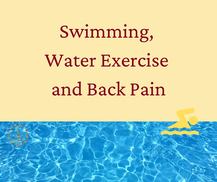
Swimming or water exercises are often recommended for
people with back pain.
You may have already experienced this, but it kind of hurts
to swim when your back is bothering you!
Classic freestyle requires a certain amount of extension and rotation of the spine.
One way to work around that and use swimming to help you when your back hurts is to keep your core slightly engaged, don't kick with your legs and let them drag lower in the water.
So it will be an upper body freestyle stroke, and I would focus more on the reaching component of the stroke versus the upward motion of the arm.
You're creating a nice elongation action through the torso..ahh
You can alternate laps with a kickboard - try putting the kickboard under your head and be on your back as you kick.
It's very easy on the neck and shoulders and is a great workout for the legs!
It's harder than you think
Water exercises in general are a little bit more user-friendly.
If your back hurts more while you are walking in the water or doing knee lifts etc. you are probably going through too big of a range of motion and not stabilizing your spine.
Focus again on slight core activation to help stabilize your spine and keep the steps and leg movements at a range that doesn't aggravate your back.
Of course the same goes for any arm movements that you may want to include.
You can do some nice stretches for the trunk and low back using the edge of the pool, the possibilities are endless!
Reach out anytime if you would like some specific ideas for your current situation, we can schedule a session or even do a half hour video session to go over great ideas for you.
people with back pain.
You may have already experienced this, but it kind of hurts
to swim when your back is bothering you!
Classic freestyle requires a certain amount of extension and rotation of the spine.
One way to work around that and use swimming to help you when your back hurts is to keep your core slightly engaged, don't kick with your legs and let them drag lower in the water.
So it will be an upper body freestyle stroke, and I would focus more on the reaching component of the stroke versus the upward motion of the arm.
You're creating a nice elongation action through the torso..ahh
You can alternate laps with a kickboard - try putting the kickboard under your head and be on your back as you kick.
It's very easy on the neck and shoulders and is a great workout for the legs!
It's harder than you think
Water exercises in general are a little bit more user-friendly.
If your back hurts more while you are walking in the water or doing knee lifts etc. you are probably going through too big of a range of motion and not stabilizing your spine.
Focus again on slight core activation to help stabilize your spine and keep the steps and leg movements at a range that doesn't aggravate your back.
Of course the same goes for any arm movements that you may want to include.
You can do some nice stretches for the trunk and low back using the edge of the pool, the possibilities are endless!
Reach out anytime if you would like some specific ideas for your current situation, we can schedule a session or even do a half hour video session to go over great ideas for you.
